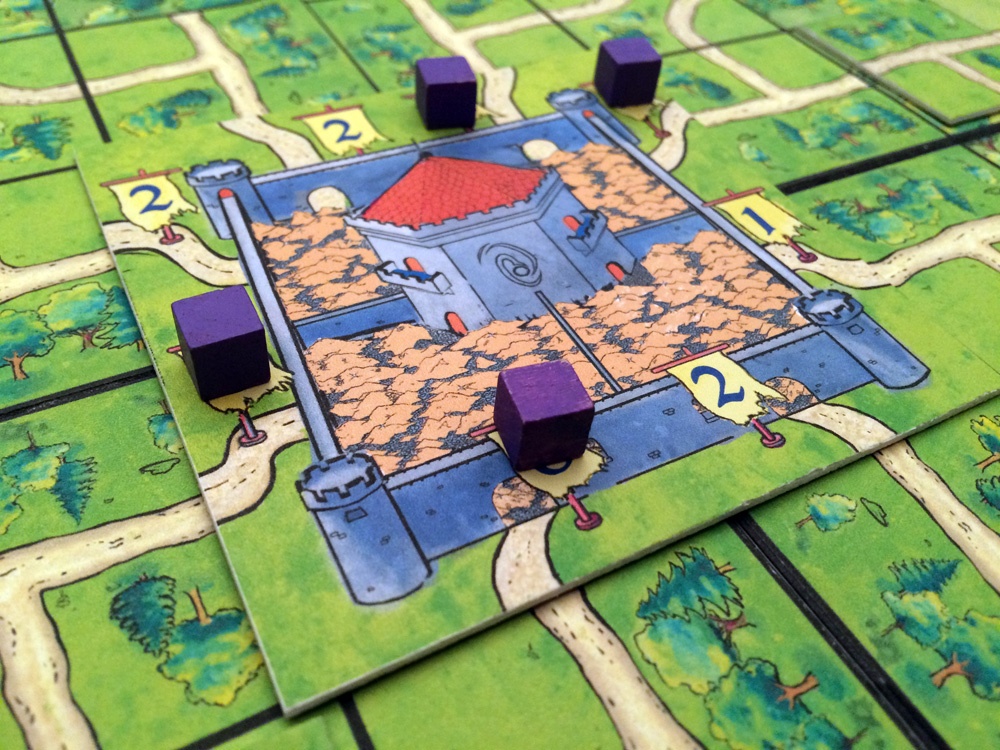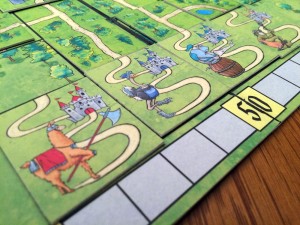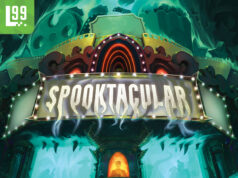Note: This preview uses pre-release components and rules. What you see here may be different from the final, published game.
 When I was doing a report on the Gold Rush in the United States back in high school, I was fascinated with the claiming rules used during that time. Basically it boiled down to if you were the first one to discover gold or any mineral deposit the land is yours. That same basic principle applies to the game we will be preview today. The Kingswood is a tile placement and role selection game set in a mystical world where players take charge of animal Merchant Houses. Each house is attempting to claim the newly discovered treasure at the heart of The Kingswood. Let’s get into the preview to see if this game is something you would like to support on Kickstarter.
When I was doing a report on the Gold Rush in the United States back in high school, I was fascinated with the claiming rules used during that time. Basically it boiled down to if you were the first one to discover gold or any mineral deposit the land is yours. That same basic principle applies to the game we will be preview today. The Kingswood is a tile placement and role selection game set in a mystical world where players take charge of animal Merchant Houses. Each house is attempting to claim the newly discovered treasure at the heart of The Kingswood. Let’s get into the preview to see if this game is something you would like to support on Kickstarter.
Game Overview:
The Kingswood wasn’t considered a very profitable place. That was until a fantastic treasure was discovered in the center of the wood. In the game, players are trying to earn gold as quickly as possible. They do this by building or paving over road tiles to connect their forts to the treasure gates at the center of the board. Players will also have special role cards that can help them build more roads, earn gold, place soldiers, and other actions that will help their merchant house earn enough money to buy Kingswood outright. The game will continue until a player has accumulated over 50 gold and has won the game.
How to Play:

The game starts with each player selecting a merchant house and the associated role cards. After placing their forts around the outside of the board, a treasure tile will be placed in the middle of the board. The treasure tile will have eight gates that will all have values that represent how much gold a players will earn if they can connect one of their forts to it. Players will also get a kings favor card that helps break ties in the game. Once players have drawn four road tiles the first round can begin. Each round consists of four phases:
1. King’s Hand Phase
If a player has reached 25 gold at the start of this phase, the person with the lowest gold total takes a new treasure tile and places it the middle of the board. During each round, players will select one of the five role cards they have and reveal them. Each player will have a Merchant, Real Estate Agent, Foreman, Soldier, and Spy cards and they are numbered one through five in that order. That number determines the play order for the rest of the round.
2. Role Phase
They all have two actions on the card representing Bureaucrat and Official actions. In ascending order, players will first complete their Bureaucrat action. If they are the only person to play that chose that role, they also get to take the Official action.
3. Roads Phase
In turn order, each player will take two of the tiles from their hand and play them on the board. They can place them anywhere on the grid, even over a tile placed by another player. Then players will be able to claim gold from one of the entrances they have connected to a fort. When a player claims an entrance, no other person can earn gold from it for the rest of the round. Finally, the player will draw back to four tiles.
4. Rush Phase
Each gate that hasn’t been claimed during the roads phase will earn a player gold if they connect one of their forts to it. After this is done, all of the cubes placed during the round are removed and the process starts over again. When a player has passed 50 gold the game is over and they win the game.

Game Experience:
When I first looked at The Kingswood I was drawn in by the two core mechanics in the game, role selection and tile placement. These are mechanics that I love to see in games due to my personal taste, but before I talk about how those work I want to spend a little time on the theme of the game.

I initially wasn’t a fan of the decision to use Llama, Ostrich, Sloth, and Manatee to represent the four merchant houses. However after playing the game, the lighter theme works in this game. The mechanics are on the lighter side, with no overly complicated rules or charts to consult. I tend to like a more relatable theme when I play a deeper strategy game. The theme and mechanics blend together well in The Kingswood.
I enjoy role selection in games because it gives people plenty of options on their turn. Rather than having another player block a location for your worker or not being able to afford an action you can look at your deck and chose what is best for you. The role selection in this game is relatively standard. With players having to decide how early they want to go during the round and what actions they will take. The game does have another layer that makes this process different from most other games. Each card has the two possible actions you can take on your turn. I like this mechanic because it gives more suspense to the role selection mechanic. You will be hoping no one else decided to play the same card as you. This adds more options and fun to this otherwise boring process. All five roles affect the game very differently and feel very balanced. It makes the decision on which one to play more difficult.

The tile laying aspect reminds me a lot of Carcassonne, but with more constraints. There isn’t the opportunity to have weird offshoots of land and roads that go off to nowhere. By having the fixed grid where you can place tiles allows for each placement to be much more impactful. Each placement causes a ripple effect and creates a puzzle that you have to consider before you place a tile. This game can cause rifts between friends because it’s easy to place a tile down to block one of their forts, because there is no restrictions on how you place that tile. This hurts player’s chances to get gold if they go early in rounds. By having the two phases where you can earn gold, it allows for the game to be very balanced. I liked this level of interaction between players, I don’t care for the 2-player version of the game because there isn’t enough for me. I found the higher player counts to be a much better experience.
Final Thoughts:
The Kingswood manages to meld role selection and tile placement into an interesting game while adding new wrinkles into these mechanics. Each role you can select is very different and the bonus action adds more to the revel process than in other games. The limited space on the grid allows for the tile placement to have a high level of interaction and frustration that generates some of the most entertaining moments in the game. If The Kingswood sounds like a game for you and your gaming group consider giving them your support.
If you’d like to become a backer, pledges start at $42 CAD the full game and all stretch goals. The Kingswood is scheduled to be in backers hands in September of 2015 and you have until Wednesday, February 18th to become a backer. So head over today and check it out.
As always, we don’t post ratings for preview copies as the components and rules may change from the final game. Check back with us after the game is produced for a full review.




















